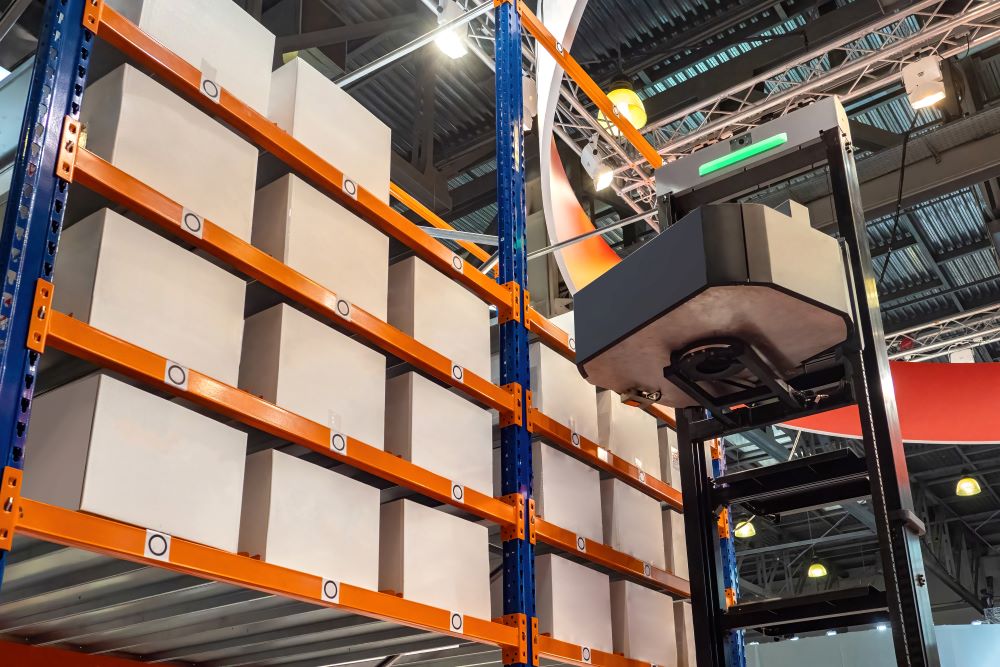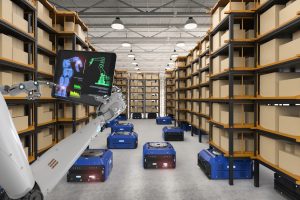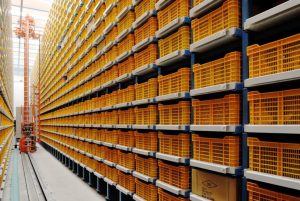In the latest instalment of BoxLogic’s Warehouse Automation series Belinda Scott, Senior Consultant investigates Carton Transfer Unit AMRs.
In this post, Belinda discusses an AMR (Autonomous Mobile Robot) technology called Carton Transfer Units (CTU), outlining how they work, where they are used in addition to the pros and cons of using CTUs.

Introduction to AMRs and CTUs
An AMR is a type of robot that moves autonomously between multiple points using a combination of sensors to interpret its surroundings. The AMR is fed tasks through a control system, typically loading or unloading a unit (either pallet or tote). AMRs have the inbuilt intelligence to be able to work in environments with humans (i.e. all the safety functions) and can work around unexpected obstacles unlike with AGVs. CTU AMRs handle totes or cartons and can carry multiple units at once, moving them between storage racks and G2P workstations; and vice versa.
Solution Equipment
CTU solutions can comprise of several core pieces of hardware and software:
Equipment | Description |
|---|---|
Totes | Totes are containers that are used to store product once it is putaway and awaiting to be picked. There is some flexibility of the size of totes that can be handled but this depends on the manufacturer of the AMR. Totes are not required in all solutions and cartons can be used as an alternative, subject to carton quality. |
Racking | Racking is used to store handling units within the solution. The racking is non-bespoke and must be designed to suit the units to be handled in the solution. Some solutions allow for double-deep storage and racking heights depend on the AMR manufacturer. The market typically operates between 2-10m in pick height currently although there is scope for this to increase as the tech develops. |
AMRs | AMRs are the element of the solution that performs the storage and retrieval function, making it a goods-to-person (G2P) solution. The core elements are a base that stabilises the device, a mast that can extend to reach higher racking locations, several carriers to store totes and a load-handling unit that resembles a shuttle, reaching into the racking to grab a tote or carton. |
Transfer Lifts | Although not used in every solution, to achieve higher levels of throughput lift devices are used to unload and load totes from the goods-to-person workstations and maximise the amount of time the AMRs are performing putaway and retrieval tasks. |
Workstations | Goods-to-person workstations are where human operatives interact with the system, placing items to be stored into totes as well as picking items out of totes to fulfil customer orders. They can be customised according to the end-users’ requirements. |
Conveyor | Conveyors might be used in some cases to connect the goods-to-person workstations, allowing a tote to be picked at one workstation and travel to another workstation without the need of an AMR. This is typically used within higher throughput use-cases where the same SKU is likely to be picked across many orders. |
Control System | A control system is the brains and intelligence behind any CTU solution, managing the order well and robots to maximise efficiency. The control system communicates with each AMR to advise of traffic so other AMRs can take alternative routes. It connects to the warehouse management system to receive and confirm customer orders as well as inventory holding. |
Chargers | Chargers are installed in the solution to charge the batteries within the AMRs. The AMRs can be set rules to charge at certain levels or opportunity charge when they are not busy. They are key to maintaining uptime of the solution. |
How Do CTU AMRs Work?
A typical CTU solution works as follows:
Decant
Goods are injected into the system via the workstations, where a human operative empties replenishment cartons into totes and places them onto a conveyor. They are transported to the lift device and the lift transfers them to the AMR carriers. The operative interacts with a terminal at the workstation to scan products, providing traceability to the control system of which items are in each tote.
Putaway
The AMR conducts a putaway process whereby it takes the decanted totes to empty storage locations within the racking, as directed by the control system. This will then use its ‘arms’ to push the tote or carton onto the shelf. Most control systems use the concept of ABC analysis to create hot and cold zones, where faster moving SKUs are located closer to the workstations. This is constantly optimising the slotting to minimise the amount of movement required to retrieve totes later down the line.
Retrieval
The AMR will then begin to retrieve totes required as part of the picking process. The AMR travels to the appropriate rack location, lifting the load handling device to the required storage level and retrieving the tote, placing the tote into one of the empty carrier slots. The AMR may need to perform a ‘shuffle’ to access the rear tote in a double-deep storage system. The AMR continues until it has filled the carrier slots available and then moves to the workstation lifts.

Picking
The totes are transferred from the AMR to the lifts and with totes directed to the appropriate workstation via conveyor. A picking operative, as directed by the screen at the workstation, will pick the required quantity from the presentation tote and place the picked units into an order container. Units from the same tote can be picked for multiple customer orders.
Whether the picker can work on multiple orders at the same time depends on the way in which the pick stations are customised but generally this approach reduces the amount of work for the AMRs and increases picking productivity. Completed order containers are taken away for packing and marshalling.
Where Can CTU AMRs Be Used?
CTU solutions can be used in a variety of sectors and industries where items can be stored in totes or cartons. This technology typically lets you use standard shelving locations, it would only need very narrow aisle (less than a meter wide). This solution would work well with large SKU ranges with lower stock holding with medium to low throughput per SKU.
CTUs can be deployed at various building heights, from 2m up to 10m high (based on current vendor specifications). The floor quality requirements are not particularly onerous unless deploying AMRs on a mezzanine.
Pros and Cons of CTU AMRs
A major advantage of all AMR solutions is that they are highly scalable and relatively quick to roll out. This means that the solution can grow with the business and benefits can be achieved more quickly. CTU solutions can also operate at reasonably high levels, up to 10m, allowing the clear height of a building to be well utilised.
The primary disadvantage of CTU technologies is that they currently only operate up to 10m, which may leave some space clear height redundant in taller buildings of over 12m, especially as 15m high buildings are becoming increasingly common, even as speculative builds. This may be resolved in time as the solution develops further. Secondly, they may not be as suitable in super-high throughput operations, as aisles can become congested with AMRs after a certain point.
Comparable Technologies
Businesses considering CTU technology might also consider rack-to-person AMRs (for buildings with very low clear heights), cube or hive solutions (for buildings with lower clear heights), vertical lifts (for lower throughput operations) and mini-load or shuttle solutions (for higher clear heights and throughputs).
Summary
BoxLogic has a wealth of experience in warehouse design and automation projects for a variety of cross-sector clients. From identifying suitable types of automation, analysing expected benefits and ROI timescales, through to shortlisting and suggesting vendors. Our independence means that we identify the most appropriate solution for you. If there is no case for automation, we will recommend a manual solution and help you design it.
BoxLogic is well positioned to assist you with your next Warehouse Automation project. Contact us to discuss your project today.



